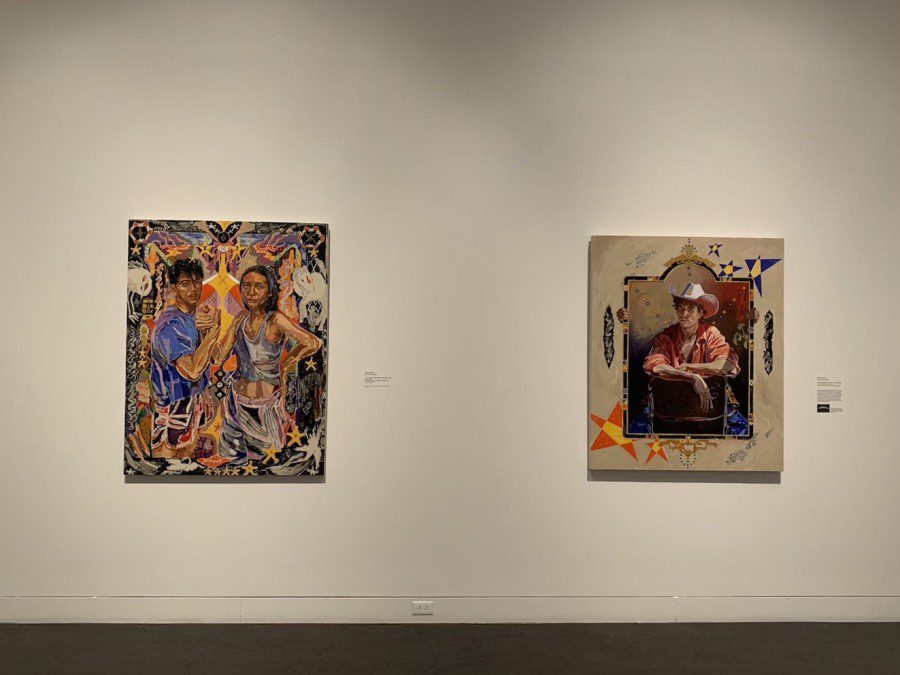Review: Oscar yi Hou’s ‘East of sun, west of moon’ celebrates artistic autonomy
Oscar yi Hou’s debut exhibition at the Brooklyn Museum confronts generalized notions of the global East and West in a celebration of queerness and Asian American communities.
Oscar yi Hou’s exhibition is on view at the Brooklyn Museum. (Natalia Palacino Camargo for WSN)
December 6, 2022
The complexities and intersections of social identities are something that artists often try to explore in their visual work. The viewer’s perception of artwork has much to do with how an artist views themselves and the symbolism of their culture. In his latest exhibition at the Brooklyn Museum, artist and writer Oscar yi Hou (侯一鸣), explores what it means to be Asian American and how to belong to American culture.
Born in Liverpool, United Kingdom in 1998, yi Hou has risen to popularity with his latest show “East of sun, west of moon” — which takes its name from a poem written by the artist. As this year’s winner of the UOVO Prize, the young artist was given the opportunity to present 11 figurative paintings at the Brooklyn Museum. yi Hou’s work is on view until Sept. 17, 2023 in the Stephanie and Tim Ingrassia Gallery of Contemporary Art on the fourth floor of the museum.
“East of sun, west of moon” explores how Western perspectives have influenced our understanding of Asian culture. The artist depicts Asian and queer subjects within the creative community. Most of the works are portraits that represent himself and his friends as East Asian characters from Western history and pop culture. “Coolieisms, aka: Sly Son Goku turns 23,” is an oil painting that represents yi Hou as Son Goku, a character of the cult favorite franchise Dragon Ball. Despite alluding to contemporary visual culture, yi Hou manages to merge traditional Eastern symbolism with his work. The border is adorned with cranes — an important motif in Chinese mythology often been associated with longevity. This juxtaposition of Eastern and Western symbols is what connects each work in this series. yi Hou seamlessly incorporates Chinese and Taoist symbols with American ones like cowboy hats, sheriff stars and the American Flag.
yi Hou’s provocative work sheds new light on the contemporary painting scene. Despite immigrating recently to the United States, yi Hou expresses his conviction of being Asian American through his work. As an artist currently based in New York, exploring the complexities of living as a queer and Asian American individual is something that comes at a particularly difficult time.
yi Hou’s exhibit comes at a time of heightened violence against Asian communities across the United States. A study from the past year evaluated hate crimes in some of the country’s biggest cities and reported a 44% increase in hate crimes, with hate crimes against Asian Americans rising 342% from 2020 to 2021. Additionally, there has been an increase in violence against the LGBTQ+ community. FBI statistics which reported hate crimes during 2020, indicate that 22.7% of victims were targeted due to their gender identity or sexual orientation. With current events such as the mass shooting at Club Q in Colorado Springs, where five people were killed and 25 others injured inside the LGBTQ+ club, queer safe spaces continue to be compromised. Oscar yi Hou’s latest work stands as a sanctuary where Asian American queer folks can feel celebrated.
The use of diverse iconography points to the tension of social identities and what it means to be Asian American. Mixing traditional macho Western imagery with queer iconography is not the only disruption that yi Hou plays with. He experiments with visual elements to deconstruct traditional Western painting. “Sayonara, Suzie Wongs, aka: Out the Opium Den” references the “geisha girl” played by Miiko Taka, and Marlon Brando’s role in the 1957 film “Sayonara,” a character that has been upheld as the height of traditional masculinity in Western culture. In yi Hou’s work, he recasts the roles with his close friends, casting the masc-presenting figure in the geisha clothing and the femme Asian figure in the traditional cowboy outfit. The figures stand out against an incomplete background distorted by bright colors and disproportionate bodies. They are accompanied by Chinese calligraphy, zodiac animals and ying-yang symbols, further recontextualizing the Western referent.
The paintings presented for the exhibition belong to the series “Coolieisims,” in which yi Hou explores the unfair criticism East and South Asians have and continue to receive from Americans. The slur “Coolie” originates from the British colonial era in denigrative reference to migrant indentured laborers from East and South Asia, but was specifically used against Chinese immigrants during a time of increased discrimination in North America, including the Chinese Exclusion Act of 1882. Not only does yi Hou’s exhibition at the Brooklyn Museum showcase his incredible skill, it also serves as a reminder that in order to change history we must learn it.
This exhibition hopes for a reimagination of history, one where we recast stereotypes and divert from the homogeneity that the Western world has assigned to queer East Asian bodies. yi Hou defies Western othering with brilliance in his Brooklyn Museum debut and reclaims violent slurs against the East Asian community to make a statement about the complexities of identity and the power of autonomy.
Contact Natalia Palacino Camargo at [email protected].
























































































































































